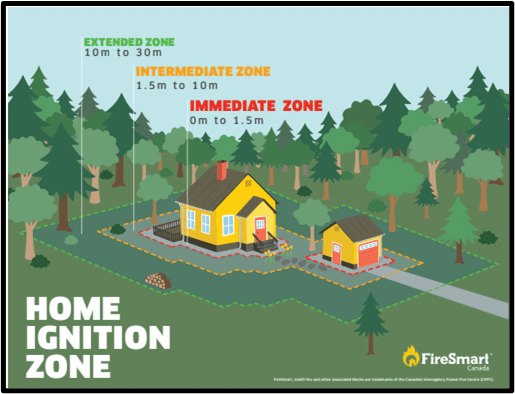Blog was submitted by Earthworm Landscape Design Co in Edmonton.
As most of us have had some personal experience with wildfires in the past couple of years, let’s consider what we have going on in our own yard to be the best prepared and to mitigate the damage if you live in a wildfire zone.
Fire resistant landscaping
Homes are often built on the boundaries of wildfire zones, and with that, there are special precautions that should be taken to help protect people and property. It is important to know the home ignition zone. FireSmart Canada has created this helpful infographic to let you know about the different zones.
The areas indicated in the image below are those that require management from the homeowner to reduce the threat of wildfire. The immediate zone is right up against the house. If you require mulch, choose rock. You may also want to consider a patio or walkway around the house. The intermediate zone is where we can plant and design freely, keeping in mind the plants best suited for this purpose (list below). The extended zone is where you keep your wood pile/storage as well as any small sheds.

As landscape designers we can help to reduce the risk by planning appropriately in these areas. Our main focus is on building materials and plant selection. The area adjacent to the house is most important. The design doesn’t have to be linear and boring. That’s where we come in. It can be creative and interesting where we make use of curved bed lines, island beds, boulders, cry creeks, sculptures, structures like arbours, a fireplace instead of a fire pit, concrete benches, ponds, etc.… The possibilities are endless. We have included a list of fire-resistant plants at the end of the article.
What does fire resistance mean?
Fire resistance means that plants do not readily ignite from flame. They may die from this, but their leaves and stems don’t add significant fuel to the fire.
- Characteristics Fire Resistant Plants:
- Moist, supple leaves
- Little tendency to collect deadwood
- Water like sap-no colour or odour
- Low sap/resin amounts
- Characteristics of Highly Flammable Plants:
- Dry, dead material within the plant
- Plant parts contain volatile waxes/oils
- Aromatic leaves
- Resinous sap
- Loose, papery bark
Recommendations
Our recommendation is to avoid highly flammable plants around the home and to consider rock mulch or stone patio/walkway around the house. Wood mulch can be used further away from the house, but it is not recommended in the immediate zone. Consider xeriscaping. Xeriscaping is a wonderful method that chooses plants with low water requirements. It is often suitable in dryer climates or areas that are prone to drought or receive little precipitation during the growing season. If you do choose to have a lush lawn, make sure that it is a healthy well, well-maintained lawn; that’s right, the lawn can serve as a barrier as the ground holds a good amount of moisture.
We hope that these recommendations and information will better prepare you to plan your landscape around your home. If you have further questions, reach out to your local landscaper in Edmonton for more information.
Plant Choices to Consider for Zone 3
| Trees |
Shrubs |
Perennials |
| Maple-Acer spp.
Birch- Betula
Ash-Fraxinus spp.
Apple-Malus spp.
Poplar and Aspen- Populus spp.
Cherry/Chokecherry-Prunus spp.
Oak-Quercus spp.
Willow-Salix spp.
Mountain Ash-Sorbus spp.
Linden-Tilia spp.
|
Green Alder-Alnus crispa
Dwarf Birch- Betula spp.
Dogwood-Cornus spp.
Beaked Hazelnut-Corylus cornuta
Cotoneaster-Cotoneaster spp.
Hydrangea-Hydrangea spp.
Honeysuckle-Lonicera spp.
Mockorange-Philadelphus spp.
Ninebark-Physocarpus spp.
Potentilla-Potentilla spp.
Currant-Ribes spp.
Willow-Salix spp.
Elder-Sambucus spp.
Spirea-Spiraea spp.
Lilac-Syringa spp.
Cranberry-Viburnum spp.
|
Yarrow- Achillea spp.
Bugleweed- Ajuja spp.
Ornamental Onion-Allium spp.
Elephant Ears-Bergenia spp.
Coneflower-Echinacea spp.
Daylily-Hemerocallis spp.
Hosta-Hosta spp.
Sedum-Sedum spp.
Thyme-Thymus spp.
Speedwell-Veronica spp.
Peony– Peonia spp.
Salvia– Salvia nemerosa
|
For more expert advice, contact Earthworm Landscape Design Co in Edmonton.
This post first appeared on https://blog.renovationfind.com